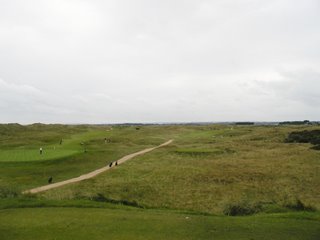Royal Portrush #5 – Drivable?
(photo courtesy of Aidan Bradley)
At 370 yards this would not be called a drivable par four in anyone’s books, but sometimes holes don’t play their yardage. The day I played there with Robert Thompson, my father and Steve Waxman we had a “real” four club wind at our backs on the 5th hole. I hit a driver, which was definitely pulled, and made the miracle carry over the valley. It bounded through the low whins and onto the front of the green. I admitted to pulling the tee shot right away, but I did hit it hard.
Now the interesting thing about this hole is it is hard downhill, with only a slight rise in front of the green. It is a cape style hole that can be shortened with a very heroic line. So under the right conditions this became a drive and pitch hole. This is one of the joys of golf in the United Kingdom, but also the crimp in my running series on short par fours. I played Baltray’s 14th into the wind and I can assure you it was more than a drive and wedge. I played the 5th at Portrush with a driver and a putter.

The 6th at pacific Dunes and the 16th at Bandon Dunes are great examples of drivable par fours where winter winds and summer winds make all the difference to our perception of what they really are. Both are driveable, or nearly drivable in no wind and that will be the definition I will stick with the list that I offer, which does not offer holes like the 5th at Portrush. Did I mention I drove that green?
The Best Short Par Fours that I can think of
Great Drivable Par Fours
#10 at Riviera 315
#9 Cypress Point 292
#12 at St. Andrew’s (Old) 316
#3 Sunningdale (Old) 298
#10 at Merion 312
#5 at Friar’s Head 330
#7 at Scarboro 290
#6 at Pacific Dunes 315
#8 at Cruden Bay 295
#14 at Gleneagles (Kings) 260
#3 Walton Heath (Old) 285
#17 Crystal Downs 311
#2 National 271
Great Drive and Pitch Holes
#8 at Pine Valley 327
#5 at Crystal Downs 355
#4 at Pebble Beach 327
#5 at Royal Dornock 359
#3 Pinehurst 335
#8 Merion 360
#4 Spyglass Hill 365
#5 Hamilton 321
#13 North Berick 347
#5 at Royal Portrush 392
#14 National GL 356
This ends my series on the short par fours



















